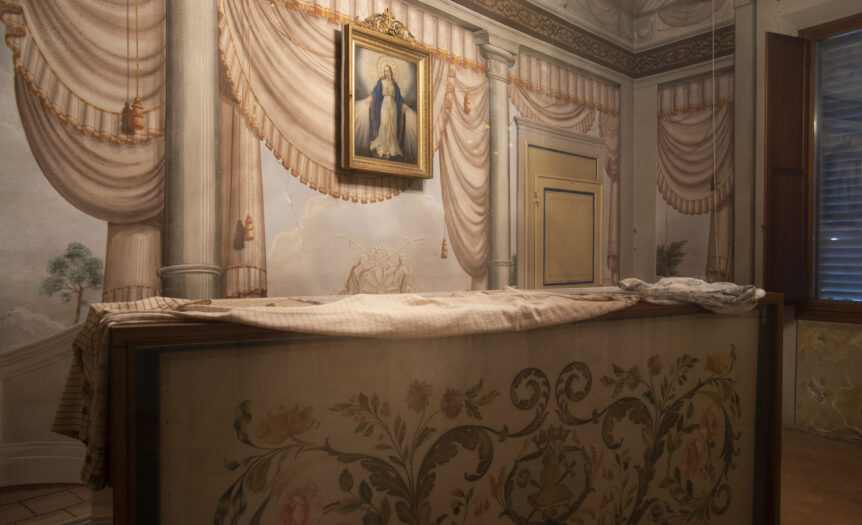Interview with Carlo Birrozzi, Director of ICCD, Istituto Centrale per il Catalogo e la Documentazione (Central Institute for Cataloguing and Documentation)
Read the other articles about the international conference
 The international conference “Charism&Creativity. Catalogues, management and innovation regarding the cultural heritage of institutes of consecrated life” has been postponed to 4-5 May 2022 due to the current global pandemic. The deadline for the call for papers has also been moved to September 27th, 2021. The conference is organized by the Holy See and our journal is its media partner.
The international conference “Charism&Creativity. Catalogues, management and innovation regarding the cultural heritage of institutes of consecrated life” has been postponed to 4-5 May 2022 due to the current global pandemic. The deadline for the call for papers has also been moved to September 27th, 2021. The conference is organized by the Holy See and our journal is its media partner.
In an effort to promote a holistic view of the cultural heritage of religious communities, attentive to both architectural containers and mobile, librarian and archival contents, we propose an interview to Carlo Birrozzi, architect and director of the Central Institute for Cataloguing and Documentation.
Once their proper use comes to an end, convents and monasteries oscillate between two extreme cases. On one hand abandonment, on the other their transformation into hotels, resorts, holiday farms… Facing these two extreme options, the Church is now claiming these structures for weaker members of our society, for the poorer and for those in need. How can we reach a compromise with the historical value that in many cases these spaces have? Which role could the Italian public authority for the protection and restoration of cultural heritage play in these processes?
Beyond the door and the walls that separated the enclosure from the outside world, religious communities have always offered social services to the city with regards to public health by means of pharmacies and hospitals, hospitality, and education. Perpetuating this vocation would certainly be opportune.
Due to the fragmentation and the diversification of properties and conservation conditions, a common reuse strategy is difficult to identify, other than being careful not to lose the value and meaning of the buildings, with the same care that is reserved for the rest of the heritage. The issue of moveable assets is instead different – such as archives and libraries, that are often a clear sign of care and attention with regards to certain aspects of collective life.
I think that the protection measures issued in the Italian Codice dei beni culturali [Code for Cultural Heritage] can be considered one of the possibilities to safeguard the cultural heritage of religious orders, but not always the most efficient. It is enough to think of the ruin to which the buildings that have not found a possible reuse are destined.
In order to identify new possible uses, I am convinced that a comparison between properties, institutes for the protection of cultural heritage and local communities is necessary. Thanks to this introductory work, churches and convents will be able to preserve a strong memory of their original vocation, showing it in the forms and functions involved in their reuse: houses and churches cannot be considered as mere and indifferent boxes.
In particular, when faced with the possibility of reusing a church, I would never forget the importance and the role that specific building has assumed over time in the evolution of the city: assuming this point of view not all uses are compatible.
Concerning the Italian landscape, the lack of a unitary census for houses and properties of religious communities is certainly one of the reasons for the fragmentation of this specific heritage. Has the ICCD carried out any experiments in this regard?
Catalogues and archives are places for the collection and preservation of information, but also for the dissemination of knowledge, and they are the more useful the more their information is structured. Thus, intertwining links between the different contents, contemporary catalogues are able to support different narratives and suggest interpretative hypotheses regarding their records.
ICCD decided to offer its data according to open-access policies and through linked open data (LOD) which allow relationships with external databases. The creation of ontologies [conceptual models suitable for the web and thus usable by machines; ed] facilitate research and associations between data.
Contemporary information technology offers indisputable opportunities in the collection of data, in their interpretation, and also in the reconstitution of units of knowledge that are no longer legible in fact.
In this regard, for example, thanks to the catalog it could be possible to reconstruct the complete map of the distribution of religious orders, existing or even extinct ones whose houses are now owned by different and multiple owners, highlighting mother-houses and filiations. The catalog can convey the diffusion and the presence of religious communities in every territory over time.
What about the preservation of religious movable heritage?
If the reuse and transformation of historical buildings follows a consolidated practice, the conservation of furnishings, libraries, archives and collections of movable objects of which the houses of the religious orders often are caskets, still has room for discussion.
I think that the valorization of these assets could be an opportunity to start a dialogue and a collaboration between local communities and the Church to identify the best way for its management.
Today even the market of antiques seems to disdain objects that only a few years ago would have delighted collectors. This contributes to diminishing the importance of the movable assets of religious orders, condemning vast collections of objects to dispersion and to the definitive loss of those uses, traditions, habits and knowledge. This process must be stopped and reversed: the community that remains, both the religious and the civil one, can oppose the progressive loss of memory.
All urban centers, major as and minor ones, host museums that can be the place to archive and display the important legacy of communities of consecrated life that are dying out. Even in the case of apparently modest objects, the relationship among them and among them and the landscape is the authoritative source of narratives.
Open and accessible catalogues are pivotal tools to foster the historical memory of religious communities and to enhance the safeguard of their traces within a specific territory. The collection of these memories and data can be also an opportunity for active participation of religious and lay communities of local inhabitants, an activity that sees them as protagonists.
Read the article in Italian language
Cover: © Elena Franco
About Author
Tag
Charism&Creativity , riuso
Last modified: 10 Maggio 2021


























